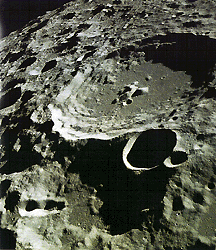
NASA
Luna
With increased confidence from the success of their Sputnik missions, the Soviet Union launched 24 Luna spacecrafts to the Moon, between 1959 and 1976. 15 were successful, each designed as either an orbiter or lander, and accomplished many firsts in space exploration. They also performed many experiments, studying the Moon's chemical composition, gravity, temperature, and radiation.
Luna 1 missed its intended impact with the Moon and became the first spacecraft to fall into orbit around the Sun. In 1959, the second Luna mission successfully impacted the lunar surface, becoming the first man-made object to reach another world. Luna 3 orbited the Moon later that year, and returned the first photographs of its far side, which can never be seen from Earth.
The Soviet Union soon learned to build spacecrafts which could perform soft landings on the lunar surface, and send back panoramic photos from their landing sites. Lunas 17 and 21 even carried roving vehicles which roamed around on the Moon's terrain.
Another major achievement of the Luna program was the ability to collect samples of lunar soil and return them to Earth, by 1970. However, these accomplishments were overshadowed by the U.S. Apollo missions which had already placed humans on the Moon by this time.






